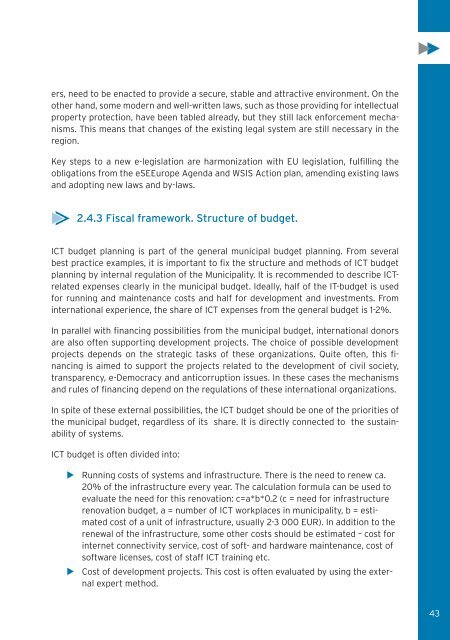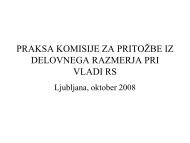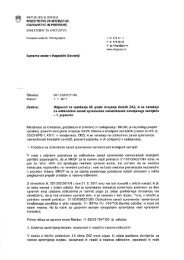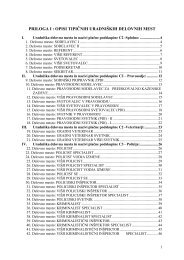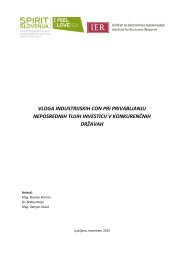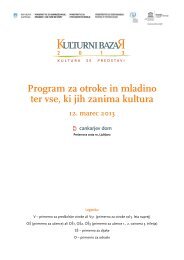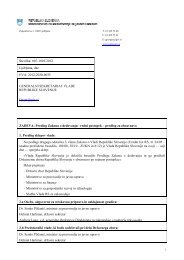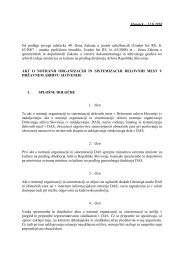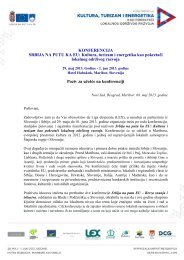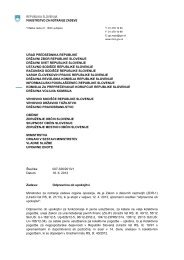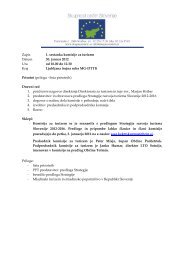for Local Governments
for Local Governments
for Local Governments
You also want an ePaper? Increase the reach of your titles
YUMPU automatically turns print PDFs into web optimized ePapers that Google loves.
ers, need to be enacted to provide a secure, stable and attractive environment. On the<br />
other hand, some modern and well-written laws, such as those providing <strong>for</strong> intellectual<br />
property protection, have been tabled already, but they still lack en<strong>for</strong>cement mechanisms.<br />
This means that changes of the existing legal system are still necessary in the<br />
region.<br />
Key steps to a new e-legislation are harmonization with EU legislation, fulfilling the<br />
obligations from the eSEEurope Agenda and WSIS Action plan, amending existing laws<br />
and adopting new laws and by-laws.<br />
2.4.3 Fiscal framework. Structure of budget.<br />
ICT budget planning is part of the general municipal budget planning. From several<br />
best practice examples, it is important to fix the structure and methods of ICT budget<br />
planning by internal regulation of the Municipality. It is recommended to describe ICTrelated<br />
expenses clearly in the municipal budget. Ideally, half of the IT-budget is used<br />
<strong>for</strong> running and maintenance costs and half <strong>for</strong> development and investments. From<br />
international experience, the share of ICT expenses from the general budget is 1-2%.<br />
In parallel with financing possibilities from the municipal budget, international donors<br />
are also often supporting development projects. The choice of possible development<br />
projects depends on the strategic tasks of these organizations. Quite often, this financing<br />
is aimed to support the projects related to the development of civil society,<br />
transparency, e-Democracy and anticorruption issues. In these cases the mechanisms<br />
and rules of financing depend on the regulations of these international organizations.<br />
In spite of these external possibilities, the ICT budget should be one of the priorities of<br />
the municipal budget, regardless of its share. It is directly connected to the sustainability<br />
of systems.<br />
ICT budget is often divided into:<br />
� Running costs of systems and infrastructure. There is the need to renew ca.<br />
20% of the infrastructure every year. The calculation <strong>for</strong>mula can be used to<br />
evaluate the need <strong>for</strong> this renovation: c=a*b*0.2 (c = need <strong>for</strong> infrastructure<br />
renovation budget, a = number of ICT workplaces in municipality, b = estimated<br />
cost of a unit of infrastructure, usually 2-3 000 EUR). In addition to the<br />
renewal of the infrastructure, some other costs should be estimated – cost <strong>for</strong><br />
internet connectivity service, cost of soft- and hardware maintenance, cost of<br />
software licenses, cost of staff ICT training etc.<br />
� Cost of development projects. This cost is often evaluated by using the external<br />
expert method.<br />
43


